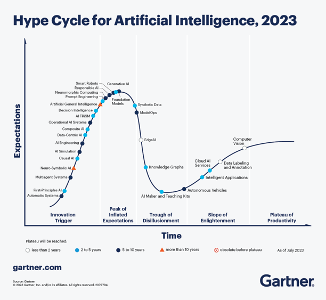Sean Betts is Chief Product & Technology Officer, Omnicom Media Group UK and NDA’s monthly columnist.
No one can deny the huge amount of hype there has been around generative AI since Open AI launched ChatGPT last November. It’s been inescapable and top-of-mind for many digital marketers this year. Unlike the ‘year of mobile’ that was always on the horizon, generative AI came out of nowhere and may represent a fundamental shift in the way we work.
I can’t help but wonder if we’ll see the usual ‘Trough of Disillusionment’ occur for generative AI and if so, when? In Gartner’s recent Hype Cycle for AI, 2023 they place generative AI right at the top of expectations with an estimate that the “plateau of productivity” will be reached in 5-10 years. Interestingly, they put Artificial General Intelligence on the cusp of inflated expectations with a time horizon of more than 10 years, but that discussion is for another time:

The Gartner hype cycle is almost a rite of passage for new technologies. However, the sheer velocity at which generative AI is traversing this cycle is noteworthy. Unlike past innovations that had a longer lifecycle – think of the gradual adoption of the internet or even mobile technology – generative AI is speeding through its journey. It effectively skipped the Innovation Trigger stage and went straight to the Peak of Inflated Expectations!
An incredible feat that can be explained in a few reasons: First, emergence – generative AI models manifest new, emergent behaviours the larger they get and ChatGPT hit a sweet spot where it had a broad range of general capabilities right out of the box.
Secondly, the technology has intuitive, easily understandable, and immediate applications, like chatbots for customer service, automatic content generation, and even mental health support.
And finally, the media coverage – generative AI has dominated the headlines in the past year, with a seemingly never-ending news-cycle.
Generative AI is obviously moving at a pace that we haven’t really seen before and there are already a few signs that it could be about to enter the next phase of the cycle, the dreaded Trough of Disillusionment. The industry is beginning to question the unbridled enthusiasm that has followed generative AI, after all, it’s not a panacea. This is highlighted in a new article from Sequoia Capital, looking at the second Act of generative AI. Its limitations are becoming increasingly apparent, from generating nonsensical or inappropriate content to the inherent biases it can perpetuate:
Ethical and legal concerns – Rightly and essentially, there is a growing focus on the ethical challenges around generative AI such as data bias, hidden labour, and copyright issues. This inevitably shines a negative light on the technology as there are some serious, fundamental issues that need to be addressed with how some generative AI models are currently trained.
User experience shortcomings – The chat interface, whilst incredibly simple and intuitive, hasn’t evolved at the same pace as the underlying technologies. As generative AI becomes more capable and produces a multi-modal experience, the chat interface needs to evolve to become more capable and responsive to users’ requirements. Don’t get me started on MidJourney – how is it still stuck in a Discord server?!
Hard to steer – It can still take an incredible amount of iteration and effort to coax a generative AI model into producing the content that you’re after. In some cases, iteration is good as it helps you generate new ideas, innovate, and refine them. But sometimes you just want the generative AI model to give you what you’ve asked for and that still isn’t as simple as it could be.
Lots of people in ‘build mode’ – Generative AI technology is still in its nascent stages; lots of experimentation but few concrete enterprise-level applications. Cohere’s partnership with McKinsey and the Lilli AI platform are some of the few exceptions rather than the norm and given the hype we’ve seen around generative AI, many people would expect (rather unfairly) to see many enterprise-level applications in the market by now. The reality is that they’re quietly being built right now, ready for an exciting 2024!
Increase of negative clickbait headlines – I’m seeing an increasing number of negative headlines declaring ‘ChatGPT is still bleeding users’ or ‘Are AI models doomed to always hallucinate?’, which is a not-so-subtle sign that the sentiment in the news industry might be waning. Some of these concerns and criticisms are absolutely fair, but the dramatic, negative language is a bit sensationalist.
Yet, for all these cautionary tales, let’s not downplay the genuine disruptions that generative AI has already delivered. Content marketing, customer service, and even sectors like healthcare are witnessing a transformation. Generative AI technology may be less of a future promise and more a present-day reality, albeit one that is still evolving, for some very important reasons:
The pace of generative AI development – The development cycle for generative AI applications is incredibly fast. We’re seeing upgrades and new capabilities rolled out at an unprecedented speed, which promises that even if we’re slightly disillusioned today, the technology should win us back tomorrow.
The chat interface is a new UI paradigm – Despite the current shortcomings outlined above, I believe the rise of chat interfaces is a new user interface paradigm. Yes, they need to evolve and become more sophisticated, but they are the natural language gateway to incredibly sophisticated and capable technologies, putting advanced technical capabilities into the hands of everyone faster than we’ve ever seen before. This is why the first generative AI technology that Omnicom has announced is Omni Assist, a chat interface for Omni, our open operating system that helps marketers orchestrate better outcomes.
Generative AI has knowledge work in its sights – There have been many disruptive technologies over the decades, but none have put a dent in the services industry, or broader knowledge work. Generative AI is set to change that, especially in sectors where the barriers to entry are high due to expert knowledge being required or being technically complex. Models like ChatGPT don’t require any technical knowledge to use and allow users and businesses to access sophisticated AI capabilities without needing a team of data scientists or software developers.
Whether you’re an evangelist or a sceptic, generative AI is not just a fad; it’s a transformative technology. The journey through the hype cycle may be quick, fraught with ethical dilemmas and inflated expectations, but there’s no turning back now…and it’s likely to be as exciting as it is unpredictable.







